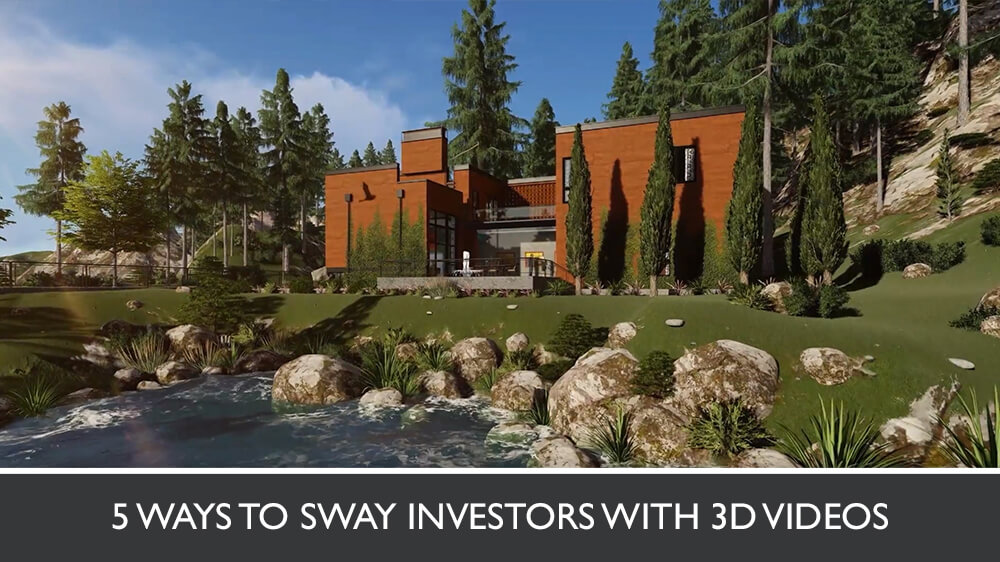Architects create breathtaking designs, but before they can be brought to life, they need to be approved by clients or investors. To secure project approval, many architects opt for a 3D architectural presentation. Photorealistic three-dimensional visualizations of blueprints and sketches, especially in the animated form, can convince even the most skeptical audience.
However, it is needed to bear in mind that 3D animation for construction is a tool, and requires a proper application. So how does one pull off a stellar design showcase? Join us as we explore 5 working techniques for an impressive 3D architectural presentation!
#1. Show, don’t tell
Words are not enough to impress investors — they need to see the property they are going to spend their money on. To give them what they want, a 3D architectural presentation is the best possible solution. Photoreal CGI materials can show how the future building will look from all angles, and even in different seasons and times of the day.
However, photorealistic images are not always enough to sway the stakeholders. To certainly convince them, 3D animation is the real kicker. It can win the stakeholders’ interest by showing the project in motion. With a 3D animation, the investors will see how great the interior or exterior will look when it’s built and how functional it will be — layout, facilities, structure — all summed up in a dynamic CGI movie. To enrich the viewer’s experience, 3D artists often add beautiful soundtracks to 3D videos. The right combination of CG footage and music is just bound to impress the stakeholders.
#2. Focus on selling points
The selling points of any architectural project are unique and must be accounted for. 3D videos can make them the focal point of the 3D architectural presentation with a few cinematographic techniques.
For example, distinctive style elements can be brought to the forefront with zooms and panning shots. Material quality can be recreated accurately with 3D modeling and rendering software and showcased subtly but memorably, as part of the overall feel of the future property. If the goal is to show the convenient layout of, say, a commercial lot, the 3D video may come in the form of a fly-through, showing the building and the surrounding infrastructure from high above. This way, the stakeholders will instantly focus on the selling points of property, and will understand why it is worth to be invested in.
#3. Take the viewers on a journey
A CGI architectural animation should be based on a captivating scenario and tell an interesting story. It should take the investors on a journey, making them imagine themselves as the future dwellers or users of a property. For this, it is a good idea to alternate between dramatic flyover and walkthrough perspectives. This will allow viewers to both examine the surrounding area and drink in the atmosphere inside the place.
An animated 3D architectural presentation can also feature timelapses of the exterior being built or interior filled in with furniture and decor — as a part of the place’s story. CGI allows architects to experiment with their presentation — POVs, style, tone and other elements can be tweaked to create the most spectacular impression on the stakeholders.
#4. Give the property a lived-in look
Another technique that helps to make the viewers personally invested in the 3D architectural presentation, and is worth a separate point, is making a “lifestyle” animation. The idea is basically the same as static CG lifestyles, but, obviously, in video form — and with appropriate features. The secret is that the presented spaces shouldn’t be just empty walls. In order to convince the viewers that people would want to live there — and some already have “moved in” — the rooms and exteriors need some personal touches.
To achieve such an effect, 3D artists add special details to 3D movies. These can be decor elements — books scattered on a bed, a served kitchen table, a child’s room with toys on the floor, a car parking outside as the camera moves in to take a look inside the house. Also, 3D mini-movie can feature figures of people. All that would help a 3D architectural presentation paint a convincing picture of life in a future building.
#5. Let the experience sink in
Investors may need some time to process their impression about pitching, so they would need something to remind themselves of it. And when it comes to a 3D architectural presentation, they can easily get it — the digital materials can be transferred to any device. So if stakeholders didn’t seem too excited during design pitching, there is always a chance they will change their minds afterward. They will probably re-watch the CG video at home, or at lunch, or at a coffee break. Maybe that second or third viewing made the wonderful design really click for them!
Getting projects approved is not always easy for architects. But 3D architectural presentation with animated visuals eases the challenge. CGI showcases interiors and exteriors in all their glory, and 3D movies, in particular open up a lot of possibilities for storytelling. A walkthrough will make the audience feel like visitors, taking them on a virtual journey through space, and by the end of it, they’ll know its every nook and cranny. This would create a strong and lasting impression and help to seal the deal!
Want to get your architectural designs green-lit easier than ever before? Contact us for high-quality architectural animation to sway investors and sign more deals!





Good thinking. Like what you wrote about the information sinking in after the meeting. Approving design is a complex task, one needs to mull it over.